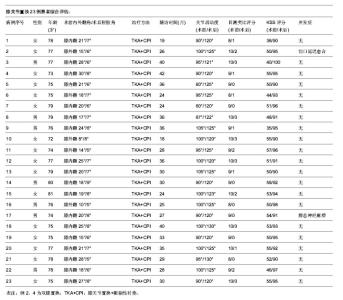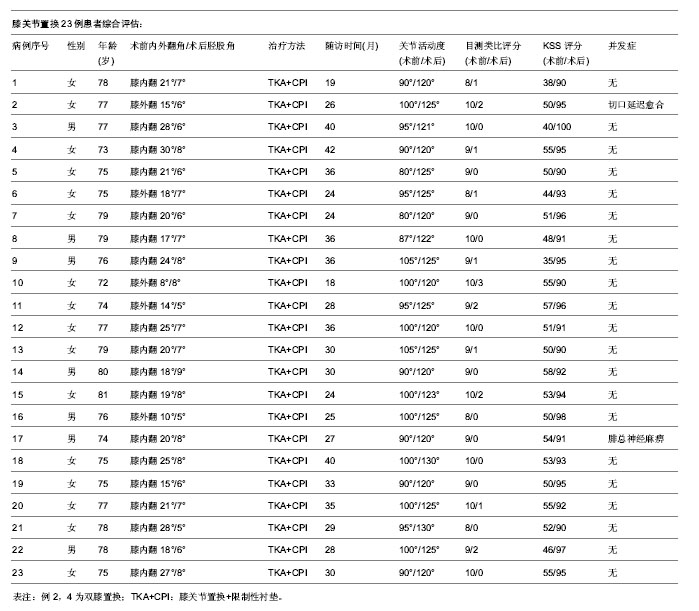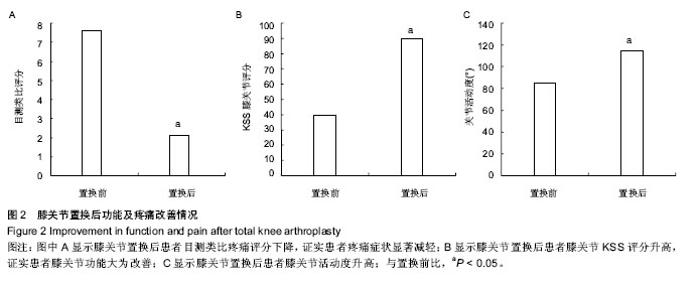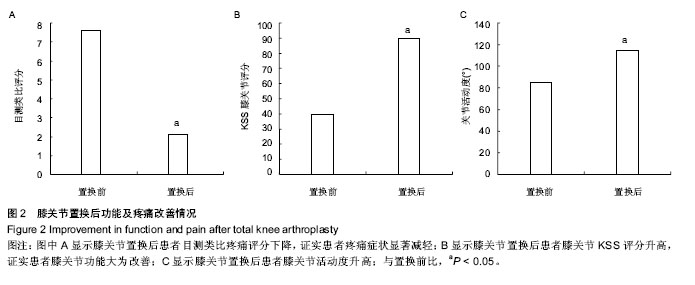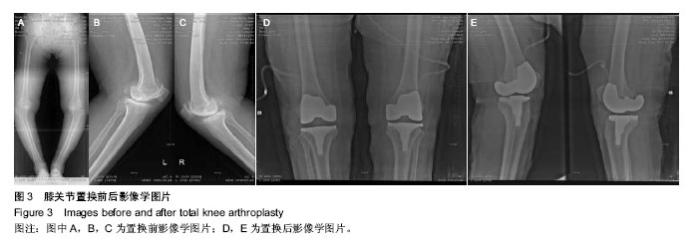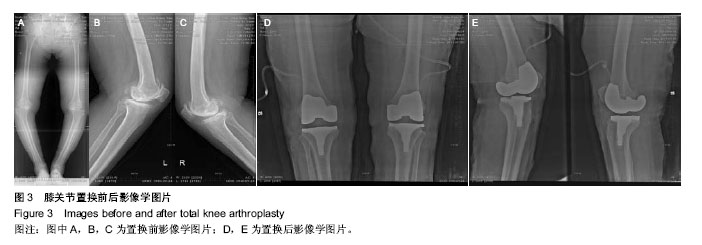| [1] Haasper C, Kendoff D, Gebauer M,et al.Revision of unconstrained total knee arthroplasty - a technical analysis.Z Orthop Unfall. 2012;150(3):290-295.
[2] Pradhan NR1, Bale L, Kay P, et al.Salvage revision total knee replacement using the Endo-Model rotating hinge prosthesis. Knee. 2004;11(6):469-473.
[3] Bistolfi A, Massazza G, Rosso F,et al.Rotating-hinge total knee for revision total knee arthroplasty.Orthopedics. 2012; 35(3):e325-330.
[4] Cheng T, Zhao S, Peng X,et al.Does computer-assisted surgery improve postoperative leg alignment and implant positioning following total knee arthroplasty? A meta-analysis of randomized controlled trials?Knee Surg Sports Traumatol Arthrosc. 2012;20(7):1307-1322.
[5] 董纪元,张健,王岩.根据患者类型选择不同类型人工膝关节假体植入后临床应用效果的回顾性分析[J].中国组织工程研究与临床康复,2007,11(8):1563-1566.
[6] Châtain F, Richard A, Deschamps G,et al.Revision total knee arthroplasty after unicompartmental femorotibial prosthesis: 54 cases.Rev Chir Orthop Reparatrice Appar Mot. 2004; 90(1):49-57.
[7] Hanratty BM, Thompson NW, Wilson RK, et al.The influence of posterior condylar offset on knee flexion after total knee replacement using a cruciate-sacrificing mobile-bearing implant.J Bone Joint Surg Br. 2007;89(7):915-918.
[8] 张志强,贾永社,李栋,等.髁限制性膝关节假体治疗严重膝内翻畸形合并胫骨平台内侧骨缺损[J].实用骨科杂志,2012,18(10): 894-897.
[9] 彭侃,姚建锋,许鹏,等.髁限制性假体治疗严重外翻畸形膝骨关节炎的疗效观察[J].实用骨科杂志,2012,18(12):1082-1084.
[10] 马涛,宋伟,张育民.半限制性假体治疗重度畸形膝关节病的疗效分析[J].实用临床医药杂志, 2012,16(13): 47-49.
[11] Vasso M, Beaufils P, Schiavone Panni A.Constraint choice in revision knee arthroplasty.Int Orthop. 2013;37(7):1279-1284.
[12] Hwang SC, Kong JY, Nam DC,et al.Revision total knee arthroplasty with a cemented posterior stabilized, condylar constrained or fully constrained prosthesis: a minimum 2-year follow-up analysis.Clin Orthop Surg. 2010;2(2):112-120.
[13] Rajgopal A, Dahiya V, Vasdev A, et al.Long-term results of total knee arthroplasty for valgus knees: soft-tissue release technique and implant selection.J Orthop Surg (Hong Kong). 2011;19(1):60-63.
[14] Elkus M, Ranawat CS, Rasquinha VJ,et al.Total knee arthroplasty for severe valgus deformity. Five to fourteen-year follow-up.J Bone Joint Surg Am. 2004;86-A(12):2671-2676.
[15] McAuley JP, Collier MB, Hamilton WG,et al.Posterior cruciate-retaining total knee arthroplasty for valgus osteoarthritis.Clin Orthop Relat Res. 2008;466(11): 2644-2649.
[16] Marti CB, Gautier E, Wachtl SW,et al.Accuracy of frontal and sagittal plane correction in open-wedge high tibial osteotomy. Arthroscopy. 2004;20(4):366-372.
[17] Takeda M, Ishii Y, Noguchi H,et al.Changes in varus-valgus laxity after total knee arthroplasty over time.Knee Surg Sports Traumatol Arthrosc. 2012;20(10):1988-1993.
[18] Lombardi AV Jr, Berend KR, Leith JR,et al.Posterior-stabilized constrained total knee arthroplasty for complex primary cases.J Bone Joint Surg Am. 2007;89 Suppl 3:90-102.
[19] Hernigou P, Deschamps G.Posterior slope of the tibial implant and the outcome of unicompartmental knee arthroplasty.J Bone Joint Surg Am. 2004;86-A(3):506-511.
[20] Lygre SH, Espehaug B, Havelin LI, et al.Pain and function in patients after primary unicompartmental and total knee arthroplasty.J Bone Joint Surg Am. 2010;92(18):2890-2897.
[21] 张强,王岩,周勇刚. 内外翻限制性假体在复杂初次膝关节置换中的应用[J].中国矫形外科杂志, 2009,17(8): 572-574.
[22] Hamai S, Miura H, Matsuda S,et al.Contact stress at the anterior aspect of the tibial post in posterior-stabilized total knee replacement.J Bone Joint Surg Am. 2010;92(8): 1765-1773.
[23] Nakayama K, Matsuda S, Miura H, et al.Contact stress at the post-cam mechanism in posterior-stabilised total knee arthroplasty.J Bone Joint Surg Br. 2005;87(4):483-488.
[24] Huang CH, Liau JJ, Huang CH,et al.Stress analysis of the anterior tibial post in posterior stabilized knee prostheses.J Orthop Res. 2007;25(4):442-449.
[25] Morgan H, Battista V, Leopold SS.Constraint in primary total knee arthroplasty.J Am Acad Orthop Surg. 2005;13(8): 515-524.
[26] Naudie DD, Rorabeck CH.Managing instability in total knee arthroplasty with constrained and linked implants.Instr Course Lect. 2004;53:207-215.
[27] Pietsch M, Hofmann S.From tibiofemoral instability to dislocation in total knee arthroplasty.Orthopade. 2007; 36(10):917-922, 924-927.
[28] Rozkydal Z, Janík P, Janícek P, et al.Revision knee arthroplasty due to aseptic loosening.Acta Chir Orthop Traumatol Cech. 2007;74(1):5-13.
[29] Peters CL, Hennessey R, Barden RM,et al.Revision total knee arthroplasty with a cemented posterior-stabilized or constrained condylar prosthesis: a minimum 3-year and average 5-year follow-up study.J Arthroplasty. 1997;12(8): 896-903.
[30] Meijer MF, Reininga IH, Boerboom AL, et al.Poorer survival after a primary implant during revision total knee arthroplasty. Int Orthop. 2013;37(3):415-419.
[31] Nam D, Umunna BP, Cross MB,et al.Clinical results and failure mechanisms of a nonmodular constrained knee without stem extensions.HSS J. 2012;8(2):96-102.
[32] Davis CM 3rd, Berry DJ, Harmsen WS.Cemented revision of failed uncemented femoral components of total hip arthroplasty.J Bone Joint Surg Am. 2003;85-A(7):1264-1269.
[33] Ahn JH, Back YW.Comparative Study of Two Techniques for Ligament Balancing in Total Knee Arthroplasty for Severe Varus Knee: Medial Soft Tissue Release vs. Bony Resection of Proximal Medial Tibia.Knee Surg Relat Res. 2013;25(1): 13-18.
[34] Bremer D, Orth BC, Fitzek JG,et al.Briard's sagittal sliding osteotomy of the lateral condyle in total knee arthoplasty of the severe valgus knee.Oper Orthop Traumatol. 2012; 24(2): 95-108.
[35] Seo JG, Moon YW, Jo BC, et al.Soft Tissue Balancing of Varus Arthritic Knee in Minimally Invasive Surgery Total Knee Arthroplasty: Comparison between Posterior Oblique Ligament Release and Superficial MCL Release.Knee Surg Relat Res. 2013;25(2):60-64.
[36] Zhou D, Lv H.Techniques of soft tissue balance in total knee arthroplasty of varus knee.Zhongguo Xiu Fu Chong Jian Wai Ke Za Zhi. 2006;20(6):602-606.
[37] Lachiewicz PF, Soileau ES.Ten-year survival and clinical results of constrained components in primary total knee arthroplasty.J Arthroplasty. 2006;21(6):803-808.
[38] Koh HS, In Y.Semimembranosus release as the second step of soft tissue balancing in varus total knee arthroplasty. J Arthroplasty. 2013;28(2):273-278. |
